Does your family have antique dishes that have been passed down throughout generations? You might be curious about them once you inherit them.
‘Where did they come from, how old are they, and how valuable are they considered today?’ are all questions you are likely to ask yourself.
On the other hand, you might be looking to buy such dishes yourself. Perhaps you are fascinated with their history, craftsmanship, or even just their aesthetics.
Or it might be the case that you neither own nor seek to obtain such dishes in the near future. Instead, you simply want to learn more about antique dishes and their interesting origins and surprising circumstances.
Regardless of your reason for being here, you are welcome to explore them; we have researched the world of antique dishes and compiled all of our findings in this article, to help answer your questions.
Table of Contents
What is considered an antique dish?
The distinction between antique and vintage china depends on how old the dish is. In general, an item that is over 100 years old is considered antique, while an item that is less than 100 years old could be considered vintage.
While this article is focused on antique dishes, you shouldn’t entirely disregard the vintage ones either. Some of the collectible vintage china could easily be just as valuable as the antique, to the right collectors!
What materials are antique dishes made from?
When thinking of antique dishes, one specific material will likely come to mind: china/porcelain. This is natural, as most well-known valuable antique dishes are made from this material, and it is also rather common in households worldwide.
However, you might be surprised to learn that there are also antique dishes made from completely different materials, albeit less common.
Glassware
One of these materials is glassware. Although not nearly as valuable or prestigious as china, glassware still ranks among the best antique dish materials. It was particularly popular in the Great Depression (the early 1920s).
Despite being fragile, glassware is appreciated for its unique features, such as the impressive forms it can be molded into, as well as the eye-catching colors that they would be painted.
You should note that the color of glassware is also an indication of its value. Clear glass is the least valuable, while purple glassware is the most valuable one. Colors such as green and pink are between clear and purple in terms of value.
Silverware
Silver is one of the rarest, as well as most valuable materials as far as antique dishes go. Because silver can take virtually any form, it is only limited by the maker’s imagination and creativity. This versatility is one of its biggest selling points.
Sterling silverware dishes were particularly common during the Greek and Roman era, when silversmiths would handcraft them. The complete sets of silverware dishes were prized by their owners and passed down through generations.
One such antique dish was sold for $10 million in 2018, at Sotheby’s auction in New York. That dish was a German soup tureen custom-made for King Louis XV of France, and it became the most expensive silverware ever sold.
Stoneware
Stone clay was also a rather popular material for pottery in the 19th century, in North America. One of its biggest advantages is durability, as stoneware dishes are some of the most long-lasting and sturdy ones.
Some stoneware dishes even look similar to porcelain ones at first sight, because crafters were inspired by the latter. There is still a major difference in the weight of these dishes though, as stoneware is much heavier and thicker.
In spite of its durability and often appealing designs, however, stoneware is considered much less valuable than the other antique dishes mentioned in this section, due to stone clay being significantly cheaper than other materials.
China/Porcelain
Despite being referred to by two different names, porcelain and china are virtually identical. The reason for these different names coexisting is based on geography and history. Also, all types of china and porcelain can be referred to as ceramic as well.
The term ‘china’ was typically used to refer to Chinese old dishes, because the Chinese were among the first to create ceramic items, as far back as 1100 BC. The original china is hard-paste, and it includes a combination of kaolin and alabaster.
Strangely enough, bone china was not developed in China, but in England, in the 1740s. This type of china is used by combining bone ash with kaolin clay and stone, and it results in much stronger, translucent, and more valuable china.
Meanwhile, the term ‘porcelain’ started being used in the 16th Century, to refer to the European ceramic items that were being produced at the time, and differentiate them from the Chinese ones, which were brought by Marco Polo and inspired them.
Which antique dishes are the most valuable ones?
There are a few specific designs and companies that are a clear sign of high-quality, highly-valuable china, that you should be aware of. However, you need to be careful, as these popular designs are often targeted by counterfeiters as well.
Chinese antique dishes
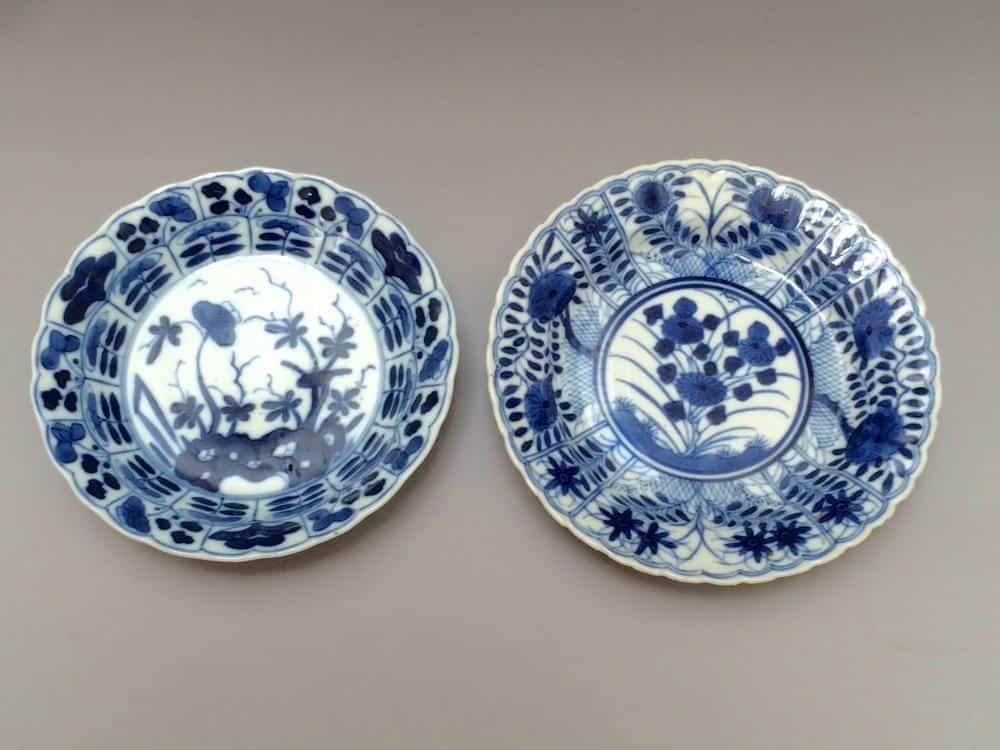
While valuable, authentic Chinese antique dishes are quite rare. Although you might think these designs are common, that is only because the popular styles were imitated in transferware and produced in great numbers.
Blue Willow
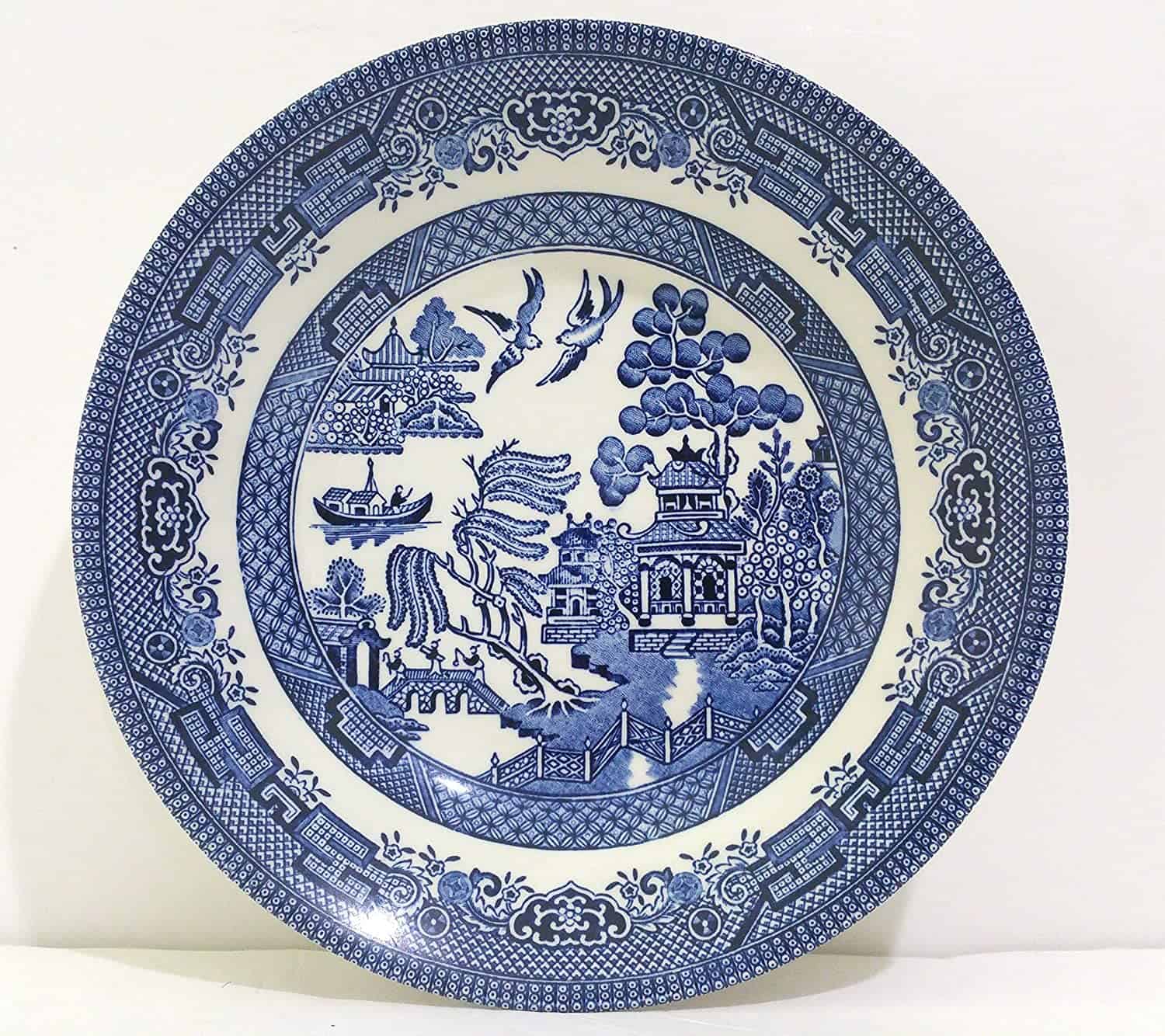
Blue Willow is one of the most popular blue and white designs. The original blue and white style used blue coloring from Cobalt oxide, which was more expensive than even gold. Its rarity and beauty inspired many to imitate it.
Although the original is rare, Blue Willow became a popular transferware design in the late 1700s, when it started being reproduced with slight variations. It’s also been produced in other colors; in such situations, it’s known as Willow Ware.
This highly beloved design tells the tragic tale of two star-crossed lovers. The design typically includes elements such as a slanted tree, a pagoda, a boat, and two doves at the top. Its value can range from $100 to $5,000.
Flow Blue
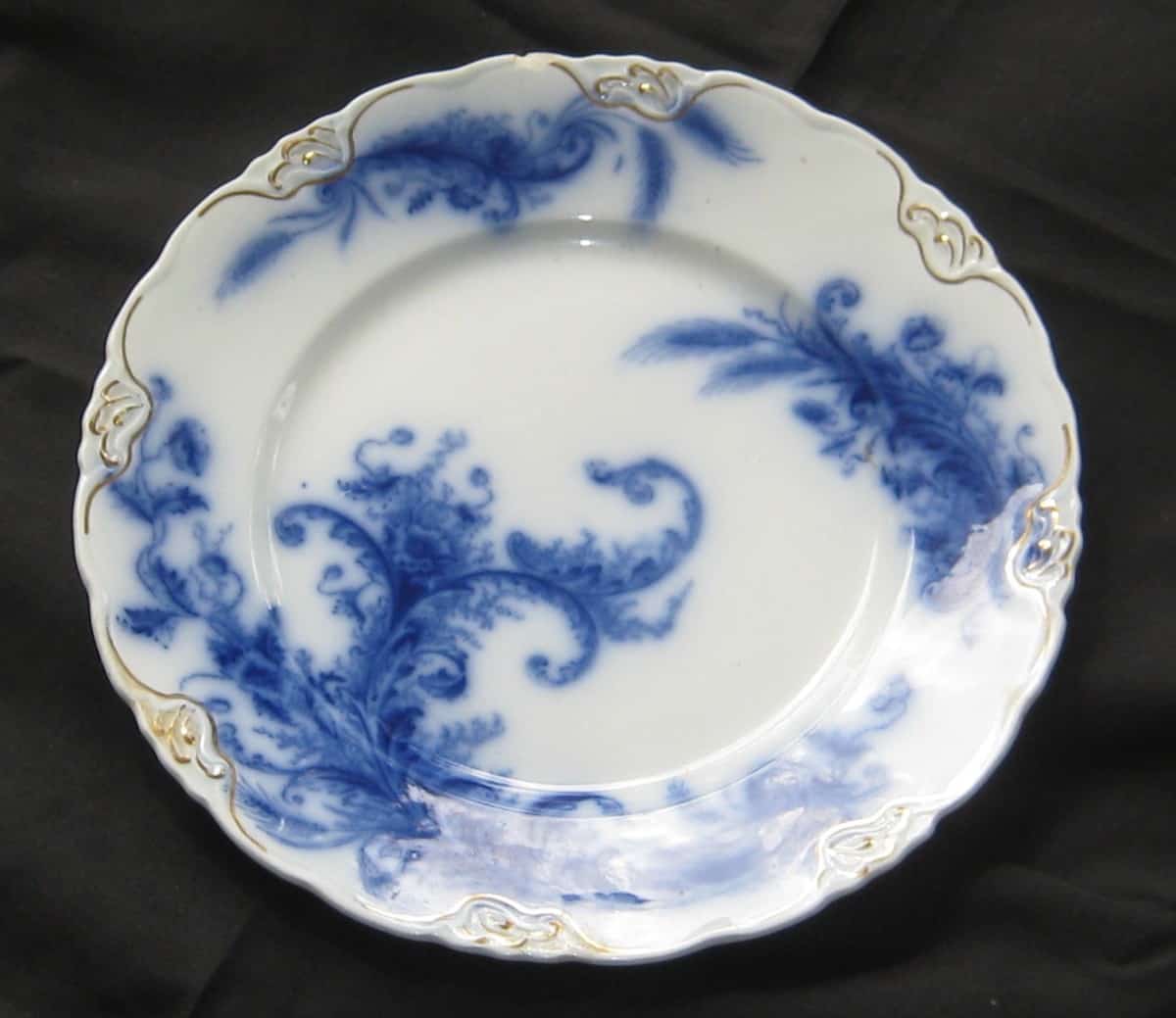
Flow Blue is another form of the blue and white style, which was first produced by accident. The cobalt color ran during firing, which created a smudged appearance.
Although this was initially deemed a failure in China, it became highly popular when it was shipped to the United States. However, its production had to be ceased during World War 1, as there was a shortage of the materials required for it.
This resulted in there being a rather limited number of original Flow Blue antiques, which are now valued for up to $500. If you are looking to buy one, beware of the fakes that were mass-produced during the collecting craze.
Blood Red Porcelain
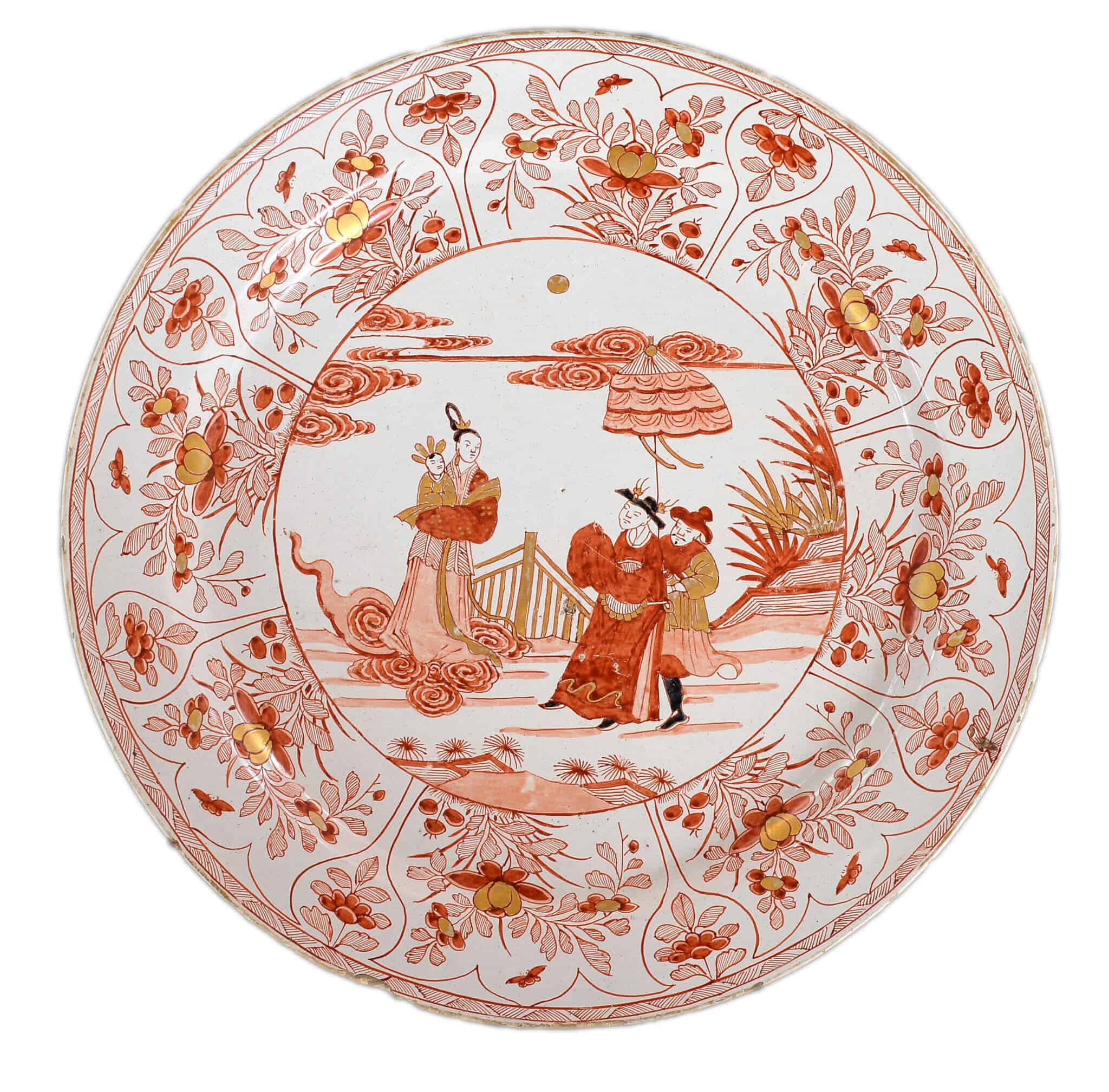
Although original blue and white dishes are rare themselves, Blood Red porcelain far exceeds their rarity, because the technique for making this design died when the Qing Dynasty fell, and few originals remain to this day.
This design is based on the superstition that red is a prosperous color, which prompted artisans to incorporate it into their creations. Using this color required top skills and extremely high-quality materials, only adding to its rarity.
As a result of its rarity, its value is equally incredible. One 17th century Kangxi-era Lotus Flower Blood Red Porcelain Bowl was sold for a staggering $9.5 million at a Hong Kong sale, according to auction house Sotheby’s.
European antique dishes
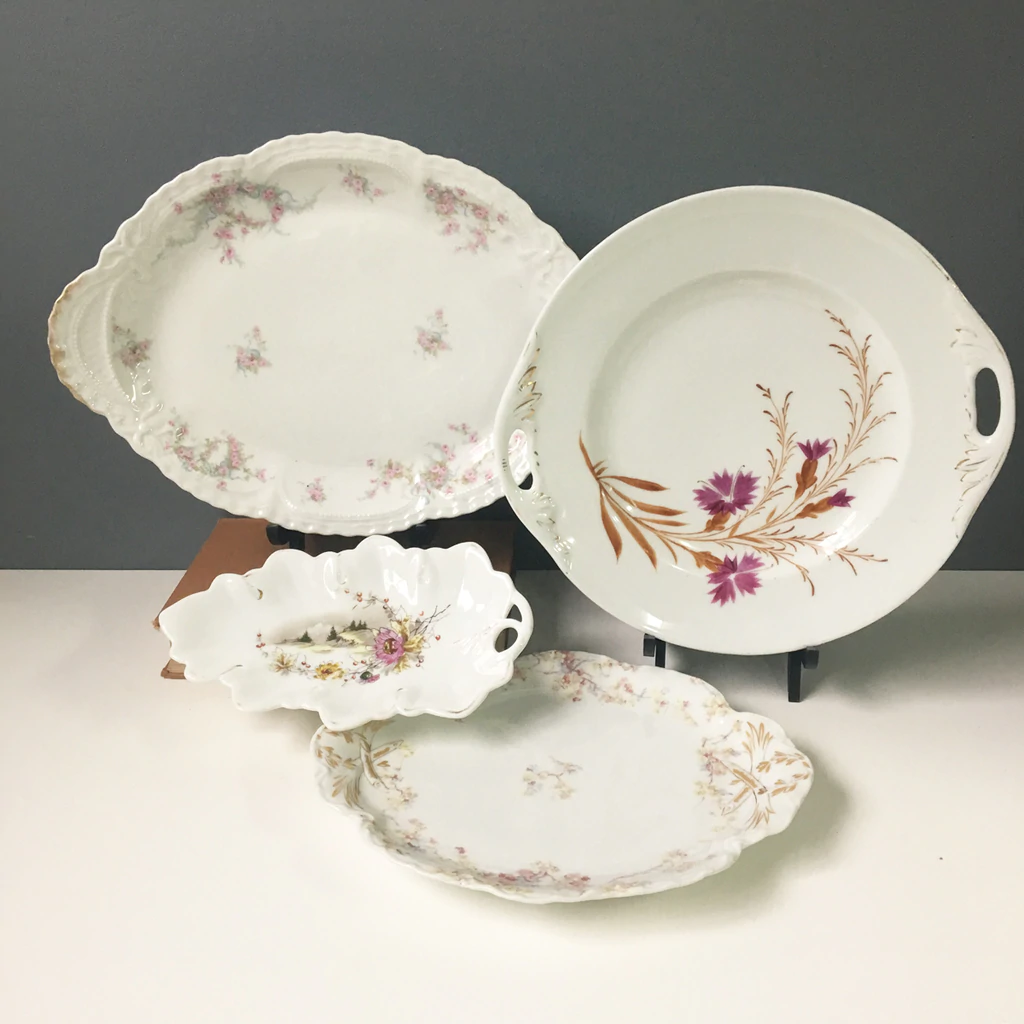
The porcelain antique dishes made in Europe are differentiated by company, more so than design. As such, there are a few specific companies from different countries that made the most recognizable and valuable antique pieces.
Meissen (Germany)
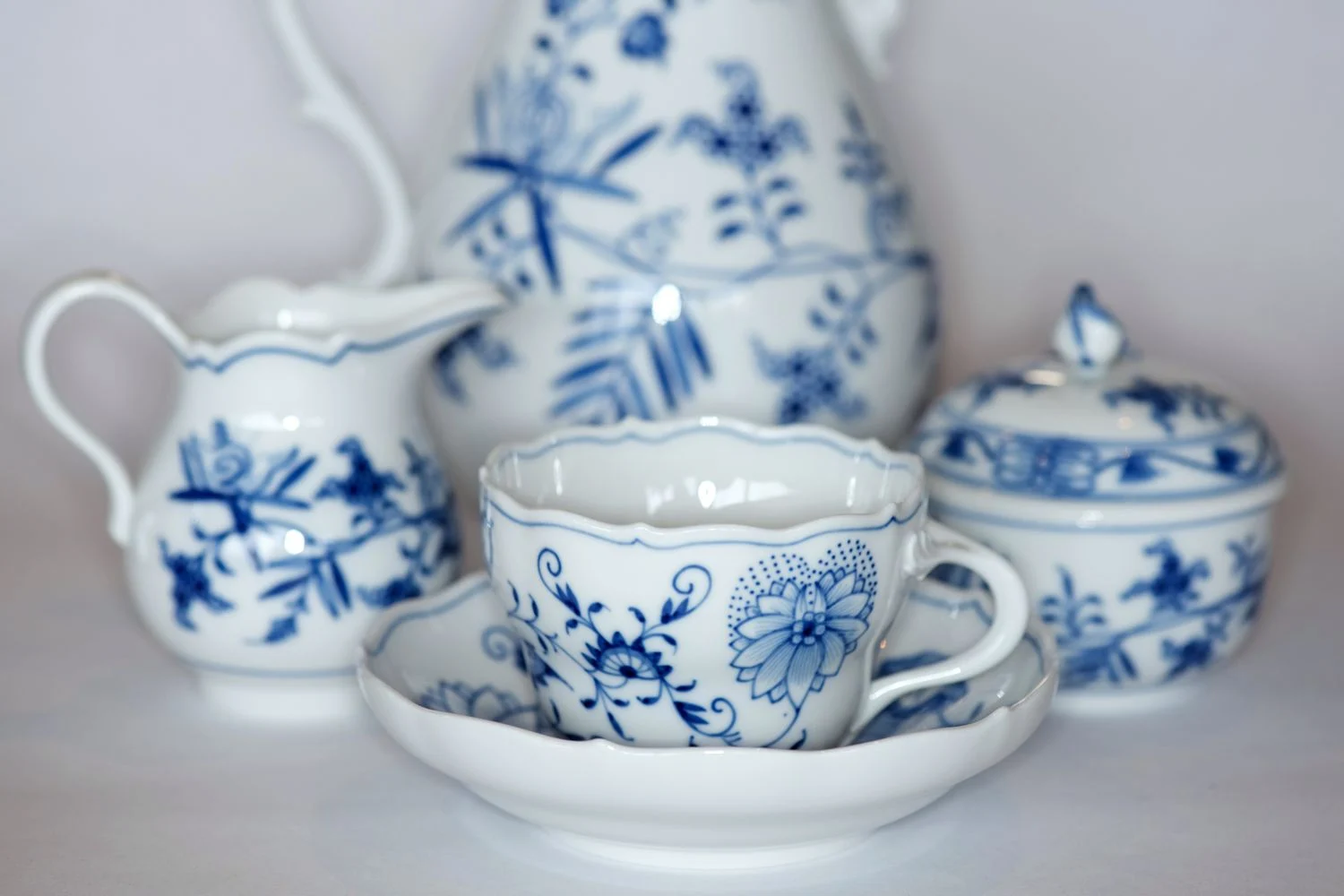
Meissen was the first European company to discover the process of creating hard-paste porcelain and use it to produce high-quality luxury dishes with sophisticated patterns. Old, authentic Meissen pieces can even be found in museums today.
Furthermore, their original designs also add to their value, as they were created by famous artists like Johann Kandler, Johann Horoldt, and Michael Victor Acier, whose work is intricate, impressive, and easily recognizable.
One particularly valuable Meissen range is the red dragon one, which features a Ming red dragon design inspired by original Chinese china. If you can see the crossed swords mark on the back, you can be sure of its authenticity.
Because Meissen dishware is considered a luxurious collectible, and can often be found in museums, owning one is priceless. The value of these pieces depends on the specific type of dishware and design, but some were sold for over $1 million.
Sèvres (France)

Sèvres antiques are not only artistically significant but also historically. This company was a result of King Louis XV’s hobby of producing soft-paste porcelain. The king founded a factory himself and sold these pieces in his private dining room.
Many of the pieces were purchased by royals who patronized the king. As such, you can be sure that most original pieces you would find today were originally owned by nobles, which makes these pieces rather coveted.
Sèvres pieces also have a rather distinct feature: a bright blue shade, which was one of the most expensive pigments in the 1700s. Moreover, when you hold a Sèvres antique dish up to the light, you can see a spectrum of light reflected through its layers.
Today, Sèvres and Sèvres-style pieces tend to sell for less than $10,000, but there have been instances of some pieces selling for significantly more. In 2011, a Sèvres gilt bronze and viole- ovoide was sold for over $175,000.
Limoges (France)
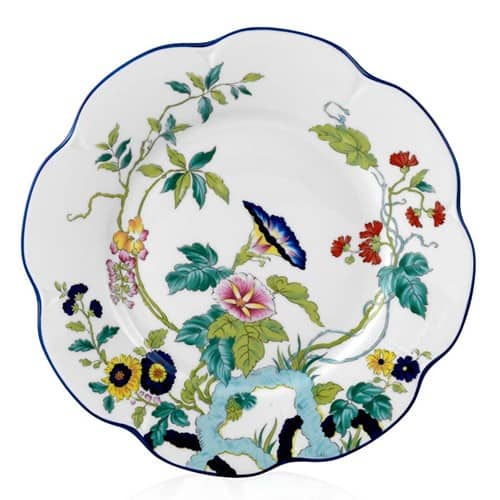
When people discovered kaolin in the Limoges region, they immediately started producing stunning, elegant porcelain dinnerware. Ever since the Limoges area became synonymous with elegant French tableware.
Limoges pieces tend to feature delicate floral patterns, as well as bright pastel colors. Some pieces even include hand paintings from acclaimed artists like Franz Bischoff and Yayoi Kusama.
As with every brand, the value of these pieces depends on the piece’s rarity and age. As such, their value can range anywhere from a few hundred dollars to a few thousand dollars.
Wedgwood (England)
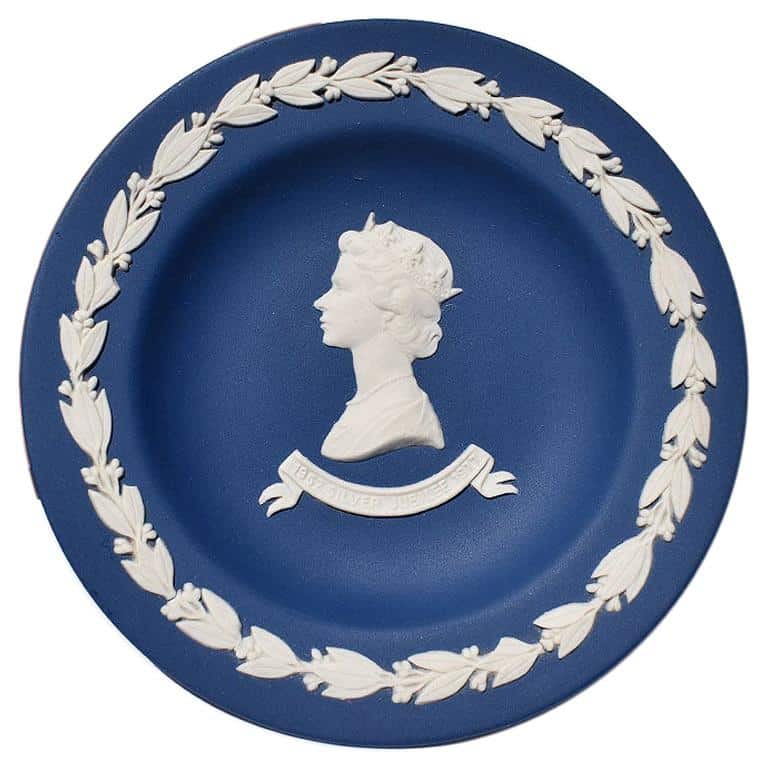
Wedgwood china was created by Josiah Wedgwood, who increased its value mainly through brilliant marketing strategies. He set up a showroom in London, solicited endorsements from high-society customers, and commissioned prominent artists.
As a result, Wedgwood dishes were common in high-society gatherings, wherein their Art Nouveau-inspired designs with stately matte finishes and hand-carved decorations were sure to draw the attention of valuable customers.
In fact, Josiah Wedgwood even made a custom tea set for Queen Charlotte of Germany, likely hoping for his product to gain recognition in a new market. Today, most Wedgwood pieces would sell for a few hundred to a few thousand dollars.
It is important to note, as a buyer, that ‘Wedgwood’ is the only accepted spelling of the company name. If you come across a piece that has a ‘Wedgewood’ marking instead (with an extra ‘e’), you should know it’s a fake.
Spode (England)
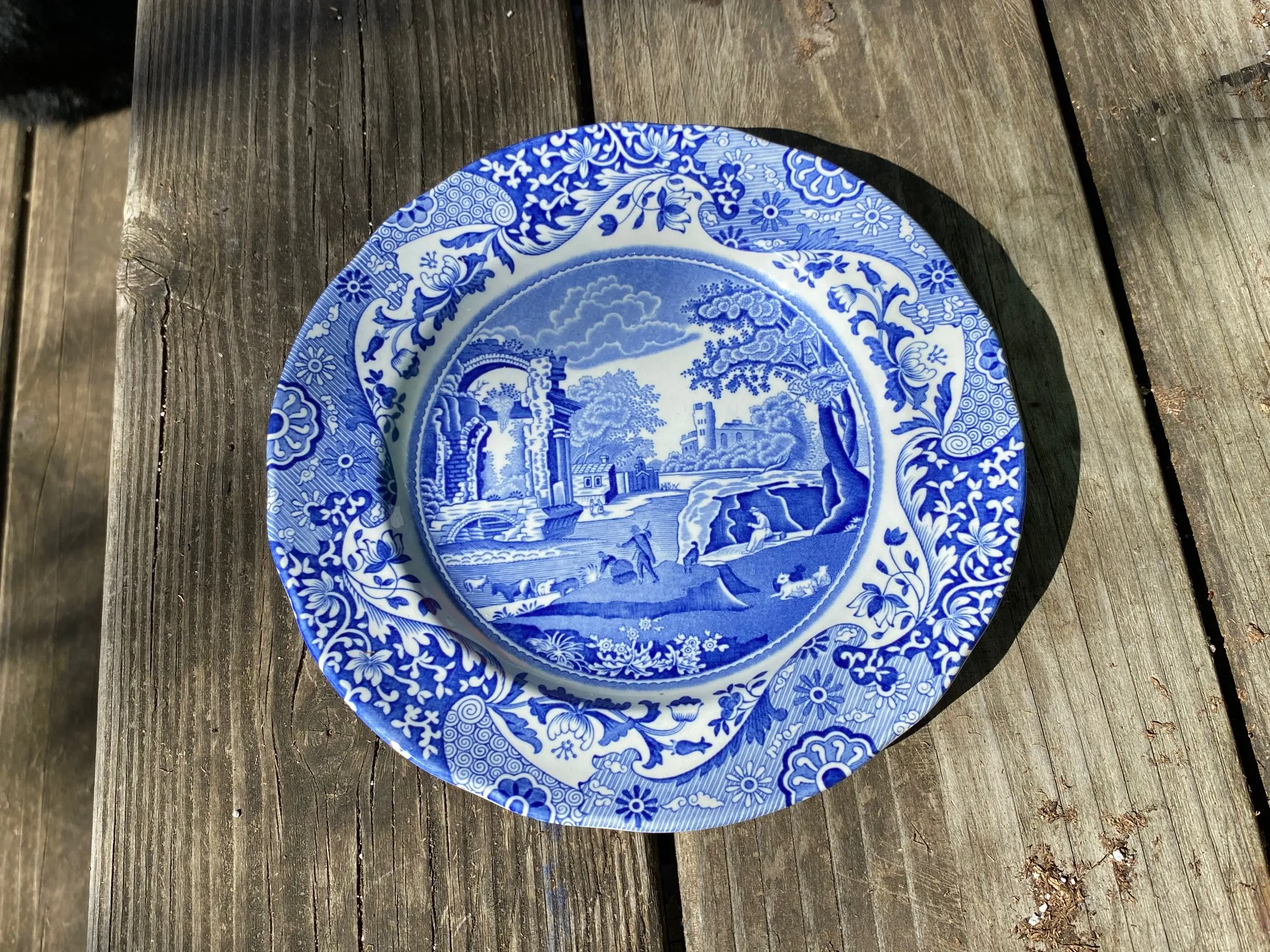
Spode became known due to its innovation. Josiah Spode, the founder, not only refined the process of producing transfer printing of engraved designs, but also improved the formula for fine bone china.
These innovations allowed Spode to easily create high-quality custom designs, such as the iconic Blue Italian range. Eventually, Spode was sold to William Taylor Copeland and Thomas Garrett, at which point the company was renamed.
Today, the company is owned by Portmeirion. Regardless, the original Spode name still holds value. Some of the original coveted sets attract values that range from $10,000, up to even $100,000.
How to identify antique dishes?
Identify the type of china
The first step is to figure out what kind of china you have. Bone china pieces are not only incredibly thin, but also significantly more translucent than the other types.
You can identify hard and soft-paste china through sound; if you hold the item and lightly tap the edge with a coin, and it makes a high-pitched tone, it’s probably hard-paste.
Find the back stamp
The back stamp is usually easy to find, being placed on the bottom or back of the piece. You can use this stamp to figure out the manufacturer of your piece, and sometimes even the date it was made, by checking a library like Kovels.
If your piece doesn’t have a marker stamp, consider taking it to a professional appraiser. Most pieces do have one, but some very early ones do not, especially early bone china.
Identify the colors & patterns
Now that you know what type of china you have, as well as the manufacturer it was made by, it’s time to pay attention to its design. This is going to be the key to figuring out the pattern number or pattern name.
Once you’ve identified the colors used, motifs (such as floral, Asian, people, animals, etc.), and overall pattern, check it against a library of patterns online, such as Replacements.com. Some manufacturers also have their own libraries.
Date your pattern
Identifying the pattern is not always going to be the final step. Some patterns were in production for continued periods (even centuries), so you’re going to need to know exactly when your piece was made.
To figure out the date, or at least the date range, take a closer look at the back stamp again. If you examine the details carefully, you should be able to find out the time range in which this stamp was used. Finally, you can estimate your antique’s value!
Is there a market for fine antique dishes?
There absolutely is a market for antique dishes. Whether you are looking to buy or sell one, you have both online and offline options available.
First of all, as a seller, even if you’ve figured out your china’s model, you might want to appraise it through a professional regardless, to ensure you get the right approximate value of the piece.
If you want to sell or buy a dish online, your best bet is likely going to be trustworthy websites such as eBay, Etsy, and especially auction ones like Christie’s and Sotheby’s. Of course, social media is always an option too!
If you’d rather not conduct this process virtually, you should consider attending a physical auction house like Christie’s or Sotheby’s. Alternatively, seek out an antique dealer.
Conclusion
Antique dishes are more complicated than they may appear at first. After all, their history is just as complicated. Their origins range from China to Europe, materials can differ significantly, and patterns can sometimes be extremely rare.
The variety in origins, materials, patterns and other external factors only further complicate these antiques. As such, you need to analyze your antique dish carefully and pay attention to the details if you want to really understand its worth and story.
If you have any other questions that weren’t answered in this article, don’t hesitate to ask in the comments below! We will gladly answer them.
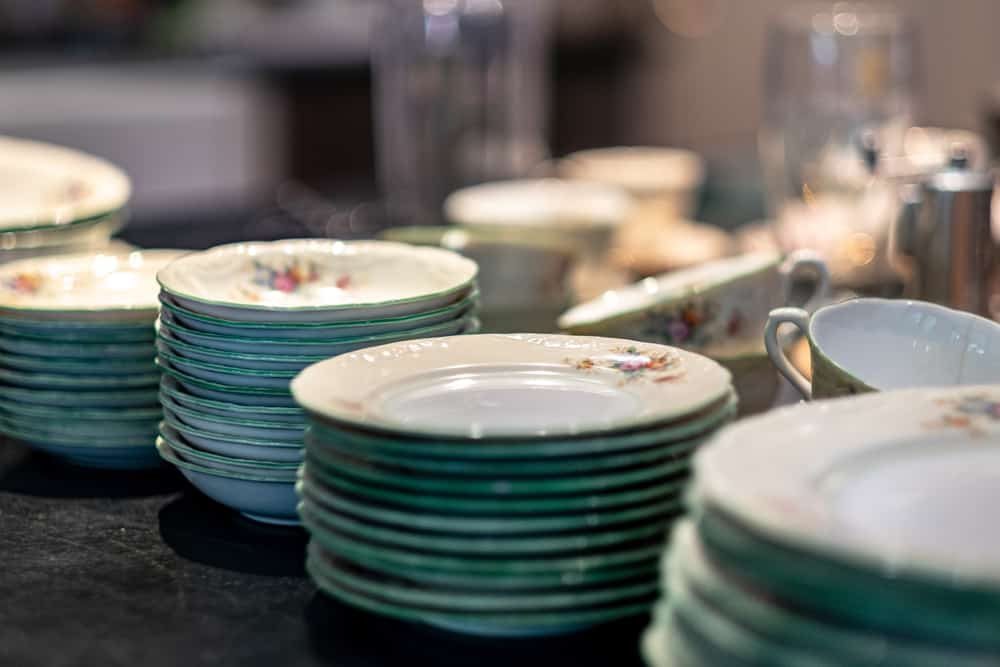
I have a 36 piece Dishware set from Germany that My Dad bought ( in about 1955 ) when he was in the US Army stationed in Germany for two years. He shipped home this set. Now that My Dad and Mom have passed I was wondering if this set is worth anything. As far are I can remember, this was never used. Who can I send a top and bottom picture to?
How about winterling Bavarian china made in Germany bought in 1960 at the base exchange.